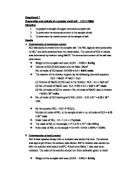Analysis of sulphur dioxide content in wine
Objective
To determine the amount of sulphur dioxide, an antioxidant, present in wine by using volumetric analysis.
Principle
All free SO2 molecules is first convert into SO32- by NaOH solution:
SO2 + 2OH- → SO32- + H2O
Acidification of the solution liberates all SO2:
2SO32- + 2H+ → 2SO2 + 4H2O
which is then titrated with 0.0057M iodine solution in which starch is used as end-point indicator:
SO2 + I2 + 2H2O → 2HI + H2SO4
Chemicals
white wine (carbonated), 1M NaOH, 2M H2SO4, 0.0057M I2, starch solution
Apparatus
volumetric apparatus, pipette, measuring cylinder, dropper, white tile
Procedure
1.> Find out the volume of wine from the label on the bottle.
2.> Pipette 25cm3 of white wine into a conical flask.
3.> Add about 12cm3 of 1M NaOH and stand for about 15 minutes.
4.> Add about 10cm3 of 2M H2SO4 to the mixture and then few drops of starch solution as indicator. Quickly, titrate the mixture with 0.0057M
iodine solution.
5.> Record the titre required to produce pale blue colour.
6.> Repeat steps 2-5 for 2-3 times.
Data Analysis

This is a preview of the whole essay
Peer Reviews
Here's what a star student thought of this essay
Quality of writing
Some errors are present in terms of grammatical constructions which make the coursework difficult to understand and as a consequence prevent its fluency. Proofreading any work to ensure it makes sense is vital to achieve maximum communication marks.
Level of analysis
In order to achieve top grades the candidate would need to match the detail found in their discussion, which incorporates evidence of additional reading and thorough discussion of the use of sulphites in wine and the reason for doing so. The areas labelled precautions and possible error would need to be expanded and more detailed analysis provided for both. It would be wise to include health and safety notes at this level of study and more specific details about the experimental procedure and possible variables would ensure the experiment was as reliable as possible. Always imagine you are explaining the procedure to someone who has never carried it out before and ask yourself what they would need to know to repeat it as exactly as possible. The conclusion is not that of an A level student and should include evaluation of the analysis and link this to the real life implications mentioned in the discussion e.g. health problems.
Response to question
This piece covers all necessary aspects such as experimental data, discussion and conclusion to varying degrees of depth and better consistency would improve its grade. Overall the candidate sets out their calculations concisely but perhaps more detailed explanation of the steps of the calculation would make their work easier to understand, it is important that coursework is clear at all times so that examiners know where to award marks. The conclusion needs to answer the question and recap the main points in detail which is not done here.







